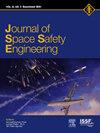Safety considerations for large constellations of satellites
IF 1.7
Q3 ENGINEERING, AEROSPACE
引用次数: 0
Abstract
The deployment of constellations of satellites within low Earth orbit (LEO) has implications for space operations and for the broader space environment. A large active satellite population will experience high numbers of conjunctions with other resident space objects (RSOs). Even if only a small proportion are high-probability events, the substantial number of conjunctions will still lead to many potentially high-risk encounters with other RSOs and a correspondingly high burden for their operators to mitigate them via maneuvers. This burden is exacerbated if the operator adopts an approach whereby risk mitigation maneuvers are conducted at collision probability levels below the widely accepted 1E-4 (1-in-10,000). Despite these significant efforts the remaining aggregate risk may still be relatively high because of the large number of conjunctions experienced by some constellations, leading to ongoing concern over the safety of these space systems. Through an analysis of conjunction assessment data, simulations using the DAMAGE computational model, and a new mapping approach, the risks from conjunctions between large constellations and other RSOs have been investigated. The results show that some existing constellations currently face more than a 10 % annual collision probability even after accounting for their robust risk mitigation approaches, with implications for the safety and long-term sustainability of large constellations and the broader LEO environment. Overall, the work emphasizes the need for new research and guidance on this aspect of space operations.
大型卫星群的安全考虑因素
在低地球轨道(LEO)上部署卫星群对空间运行和更广泛的空间环境都有影响。大量的现役卫星将与其他驻留空间物体(RSO)发生大量的会合。即使只有一小部分是高概率事件,大量的会合仍然会导致与其他 RSO 发生许多潜在的高风险碰撞,并给其操作人员带来相应的沉重负担,以通过机动来减轻这些碰撞。如果运营商采用的方法是在碰撞概率低于广泛接受的 1E-4(1/10,000)时进行风险缓解操作,那么这种负担就会加重。尽管做出了这些重大努力,但由于一些星座经历了大量会合,剩余的总体风险可能仍然相对较高,从而导致对这些空间系统安全的持续关注。通过对会合评估数据的分析、使用 DAMAGE 计算模型的模拟以及一种新的绘图方法,对大型星座和其他 RSO 之间的会合风险进行了调查。研究结果表明,即使考虑了稳健的风险缓解方法,一些现有星座目前每年面临的碰撞概率仍超过10%,这对大型星座和更广泛的低地球轨道环境的安全和长期可持续性产生了影响。总之,这项工作强调需要对空间运行的这一方面进行新的研究和指导。
本文章由计算机程序翻译,如有差异,请以英文原文为准。
求助全文
约1分钟内获得全文
求助全文
来源期刊

Journal of Space Safety Engineering
Engineering-Safety, Risk, Reliability and Quality
CiteScore
2.50
自引率
0.00%
发文量
80
 求助内容:
求助内容: 应助结果提醒方式:
应助结果提醒方式:


